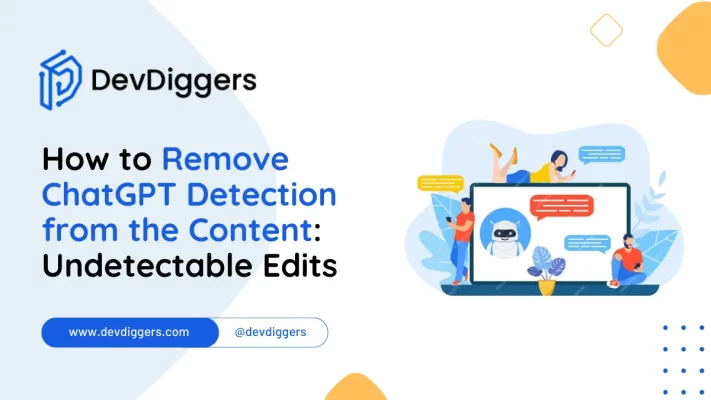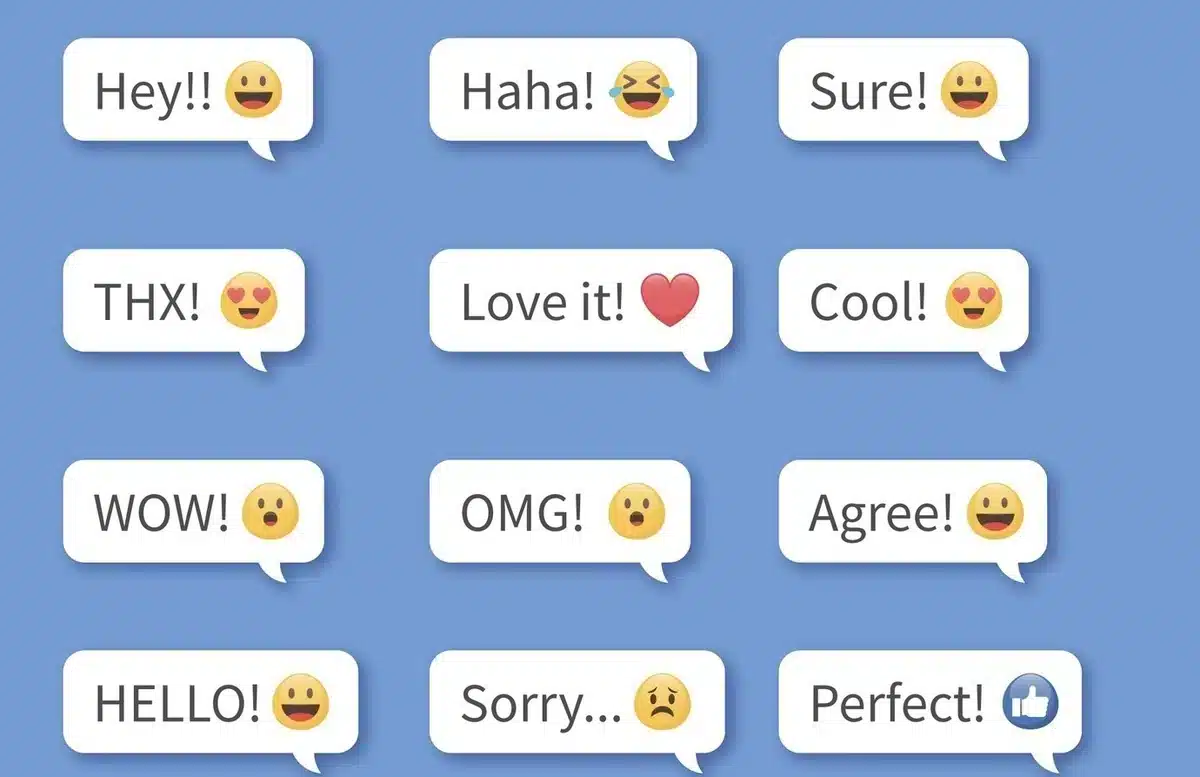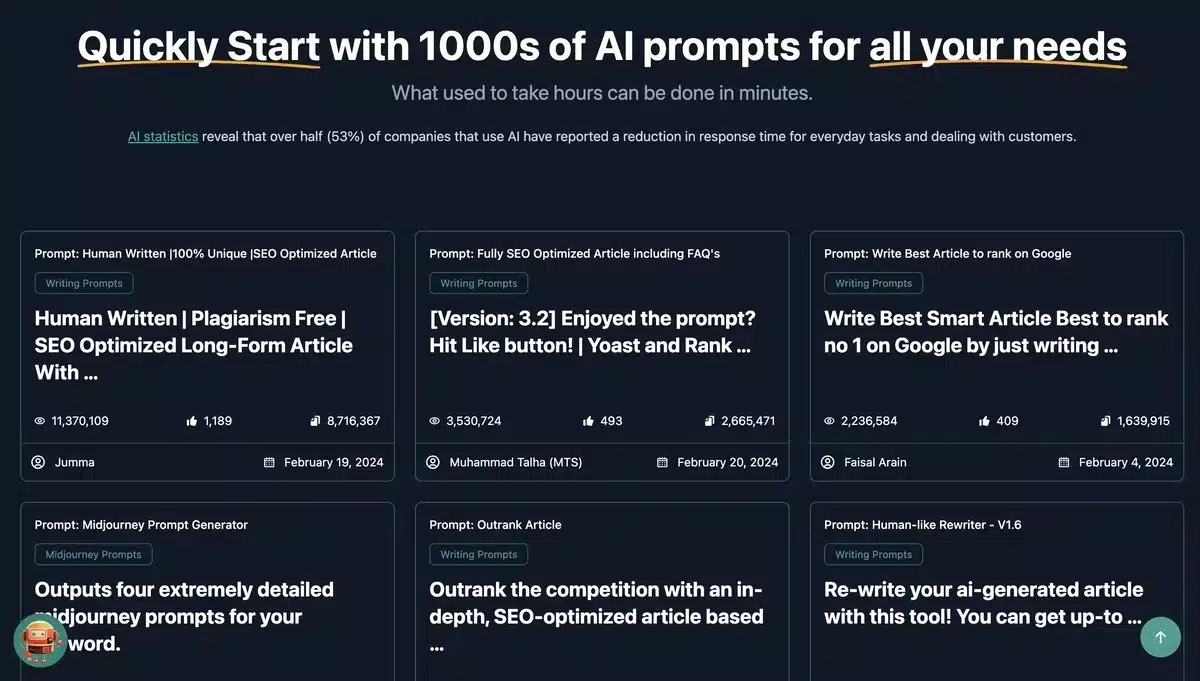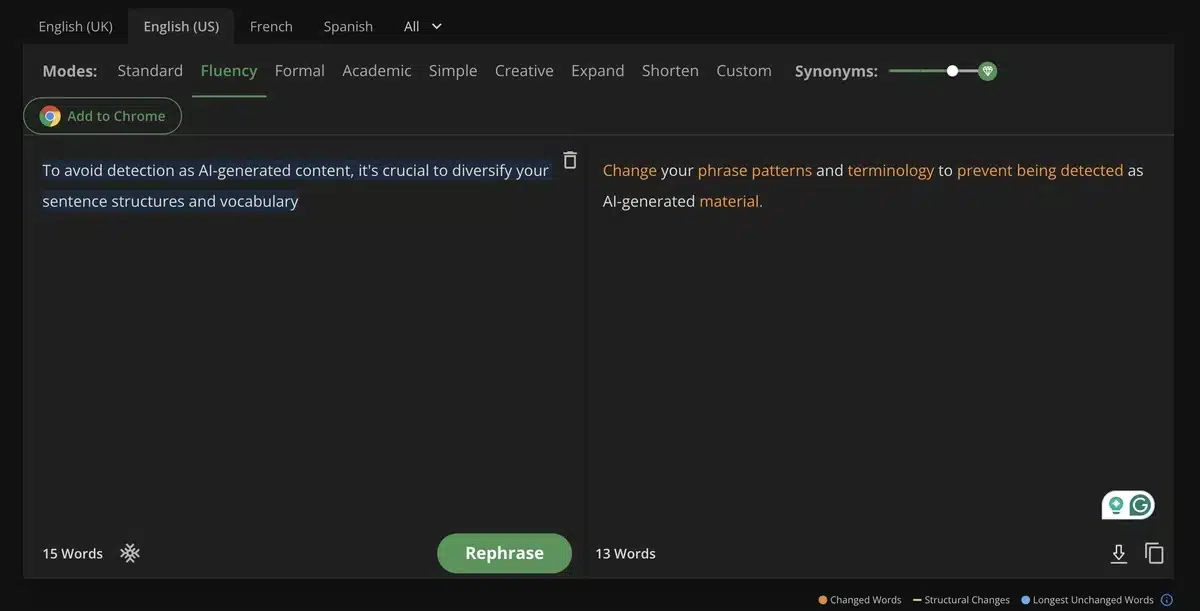- Can ChaGPT Content be Detected?
- Why Remove ChatGPT Detection from the Content?
- How to Remove ChatGPT Detection from the Content
- Conclusion: How to Remove ChatGPT Detection from the Content
- FAQs: How to Remove ChatGPT Detection from the Content
- What is ChatGPT detection, and why would I want to remove it from my content?
- Can eliminating ChatGPT detection affect my website's SEO?
- Will my content be penalized if detected as AI-generated?
- Are there legal considerations when using AI to generate content?
- What are the best practices for mixing AI-generated content with human creativity?
How to Remove ChatGPT Detection from the Content: Undetectable Edits

- Can ChaGPT Content be Detected?
- Why Remove ChatGPT Detection from the Content?
- How to Remove ChatGPT Detection from the Content
- Conclusion: How to Remove ChatGPT Detection from the Content
- FAQs: How to Remove ChatGPT Detection from the Content
- What is ChatGPT detection, and why would I want to remove it from my content?
- Can eliminating ChatGPT detection affect my website's SEO?
- Will my content be penalized if detected as AI-generated?
- Are there legal considerations when using AI to generate content?
- What are the best practices for mixing AI-generated content with human creativity?
In today’s digital landscape, the ability to remove ChatGPT detection from the content is becoming increasingly valuable for creators aiming for a seamless blend between AI-generated text and human-like writing.
This blog will explore practical strategies and techniques to eliminate recognizable AI signatures, ensuring your content retains the essence and quality of natural human expression.
By enhancing originality, adjusting tone, and including intricate human qualities, we aim to equip you with the knowledge to make your AI-assisted content indistinguishable from that written by a human.
Whether you’re looking to refine your writing with AI tools without losing the personal touch, or you’re curious about pushing the boundaries of AI’s capabilities in content creation.
This guide will offer comprehensive insights and actionable advice on how to remove ChatGPT detection from your content, making it as authentic and engaging as possible.
Can ChaGPT Content be Detected?
Yes, detecting ChatGPT content can be done through various means.
Tools and algorithms have been developed to identify patterns typical of AI-generated text, such as specific repetitive structures or phrases that these models commonly use.
The overall consistency, style, and lack of particular human quirks in the writing can also serve as indicators.
However, detection accuracy can vary based on the sophistication of the analysis tools and the extent to which the AI-generated content has been edited or modified to mimic human writing more closely.
Tools such as DeepSeek and ChatGPT have different ways of spotting AI-generated text, so the comparison of DeepSeek vs ChatGPT helps in selecting the most suitable approach for improving AI-generated material.
Why Remove ChatGPT Detection from the Content?
Choosing to remove ChatGPT detection from the content can happen for several reasons, depending on why and how the content is used.
Here are some simple reasons for doing this:
- Making It Look Like a Human Wrote It: People might want their work to seem like a person made it so others take it more seriously or think it’s more reliable. This matters a lot when people care about the human touch.
- Stopping Bias: Some people might not trust or value content if they know a machine made it, no matter how good. So, hiding that an AI made it can help avoid this problem.
- Fitting In Better: In things like customer service, you want to help users naturally. If users know they’re talking to a machine, it might not feel as good for them.
- Following Rules: Some places have rules about AI-made content and telling people if you use it. If AI helps make something but isn’t the primary creator, hiding the AI part might be necessary to follow these rules, as long as it’s done responsibly.
- Trying New Things: Creators might hide AI’s role to see how well AI and human creativity can work together without people knowing a machine was involved. This can help see how AI changes creativity and if people like the content more without bias.
- Being Ethical: The right way to use AI in making content can be tricky. Sometimes, the focus is more on how useful, accurate, or promising the content is than on who or what caused it. Ensuring the content is okay to use is more important than saying that an AI helped create it right away.
While there are good reasons to remove ChatGPT detection from the content, it’s essential to be honest and transparent about using AI and passing through AI detectors.
You can also use the AI Humanizer to make your content human-written and remove AI from your content.
How to Remove ChatGPT Detection from the Content
To remove ChatGPT detection from the content, To make the content seem less like it was generated by an AI and more like a human wrote it, follow these steps:
1. Introduce Natural Language Variations

Using natural language variations is crucial to remove ChatGPT detection from the content.
This approach involves accepting the complex, often unexpected ways that humans communicate.
Below are specific techniques, complete with examples, to demonstrate how natural language variations can effectively mask AI involvement in content creation
For Example:
Before (AI-like): “It is very important to save money.“
After (With Slang/Idiom): “Stashing some cash is key.“
2. Vary Sentence Lengths and Structures
To effectively remove ChatGPT detection from the content, one effective method is to diversify the lengths and structures of your sentences.
This strategy includes blending various sentence forms, simple, compound, complex, and compound-complex, to mimic the complex and varied style characteristic of human writing.
Here’s a closer look with examples:
- Simple Sentence: A sentence with just one main idea or clause.
Example: “Night fell.“ - Compound Sentence: This type consists of two or more central ideas joined by a conjunction or a punctuation mark.
Example: “Night fell, and the city lit up.” - Complex Sentence: One main idea is supported by one or more subordinate clauses that add additional information.
Example: “As night fell, the city lit up, revealing its vibrant life.” - Compound-Complex Sentence: This structure combines multiple main ideas with one or more subordinate clauses.
Example: “As night fell, the city lit up with vibrant lights, and even though it was late, the streets were alive with energy.“
Incorporating a mixture of these sentence types can significantly aid in your efforts to remove ChatGPT detection from the content.
It adds a layer of sophistication and variability that closely resembles human writing patterns:
- Before (More AI-like): “Night fell. The city lit up. The streets were alive. It was vibrant.“
- This version might be labeled AI-generated due to its repetitive structure and lack of sentence variety.
- After (More Human-like): “With the arrival of nightfall, the city transformed, bathed in a vibrant glow that brought its streets to life, a testament to the endless energy that pulsed through its veins even in the late hours.“
This revised version employs a mix of sentence structures to convey the same ideas, making the content feel more dynamic and less likely to be detected as AI-generated, effectively helping to remove ChatGPT detection from the content.
3. Incorporate Personal Insights and Experiences

To effectively remove ChatGPT detection from the content, a key strategy is to “Incorporate Personal Insights and Experiences” into the text.
This method involves adding personal stories, opinions, or unique insights into your content, which AI typically cannot replicate with authenticity.
Here’s how to do it with examples:
Sharing Personal Stories
Example: If writing about time management, instead of simply listing tips, you might add, “Last year, I realized my days were slipping through my fingers, so I started blocking off ‘me time’ in my calendar. It was a game-changer, especially the morning slots reserved for meditation.“
Offering Unique Insights
Example: In a piece on digital marketing trends, you could include, “From my experience running social media campaigns, I’ve noticed that authenticity beats polish every time. One behind-the-scenes video we posted doubled our engagement overnight.“
Reflecting on Personal Growth
For example, when discussing learning new skills, mention, “Picking up the guitar at 30 was intimidating, especially as someone who couldn’t read music. But three chords in, I wrote songs that spoke to my journey, proving it’s never too late to start.”
4. AIPRM Extension

To remove ChatGPT detection from the content and make it appear more human-authored, you can employ several strategies, including tools like the AIPRM ChatGPT Extension.
It contains various prompts that help in generating undetectable ChatGPT content. Some of the few effective AIPRM Prompts are:
- Human Written |100% Unique |SEO Optimized Article
- Keyword Generator
- SEO Meta Title and Meta Description
- AI Content Detector
- Plagiarism Checker
- SEO Optimized Articles With Images & FAQs
These prompts ease the generation of content and create plagiarism-free and AI-detection-free content.
5. Engage with Emotion
To remove ChatGPT detection from your content, write with more emotion.
This means making your text show feelings, like happiness, which makes it seem more like a person who wrote it, not a computer.
For Example:
Instead of saying, “Adopting pets is good,” you could say, “Getting a pet can fill your life with joy, making every day brighter with love.“
This kind of writing helps your text connect better with readers, making it less likely to detect written by ChatGPT.
6. Quilbot Paraphrase

Using tools like QuillBot for paraphrasing is another method to remove ChatGPT detection from the content.
Paraphrasing tools can rewrite text to maintain the original meaning but change the wording and sentence structure.
This can help make the content appear less predictable and more changed, a characteristic of human writing rather than AI-generated text.
For Example:
If the original sentence generated by ChatGPT is “To avoid detection as AI-generated content, it’s crucial to diversify your sentence structures and vocabulary,”
QuillBot tool might rewrite it as “Change your phrase patterns and terminology to prevent being detected as AI-generated material.”
This paraphrased sentence keeps the original meaning of the sentence but rephrases it and presents it in a way that might not be immediately detected as AI content.
7. Reflect Current Events

Including current events in your content is a strategic approach to remove ChatGPT detection from the content, making it appear more human-like and authentic.
Since AI models may not be updated with the latest news or trends, referencing recent developments can strongly indicate human authorship.
Here’s how to apply this method effectively:
Reflect Current Events to Remove ChatGPT Detection: When aiming to remove ChatGPT detection from the content, seamlessly integrating up-to-date news or developments enhances relevance and signals active engagement with the world.
For Example:
You could mention a newly enacted law or a recent high-profile data breach if writing about technology and privacy. To maintain consistency, make sure that these occurrences are closely related to the topic of your material.
Conclusion: How to Remove ChatGPT Detection from the Content
In summary, learning how to remove ChatGPT detection from the content boils down to a few straightforward strategies.
It’s about making your writing feel personal, using different words and sentence patterns, adding everyday language and intentional minor errors, mentioning recent news, expressing emotions, thoroughly reviewing your work, and including detailed information.
These methods not only help hide that AI created your content but also improve its quality and make it more engaging.
As we increasingly incorporate AI into writing, it is crucial to use it responsibly and transparently.
Ensuring that our content, whether AI-assisted or not, remains authentic, valuable, and relatable to our audience is critical.
Ultimately, mastering how to remove ChatGPT detection from the content highlights the importance of combining AI’s capabilities with the unique flair of human creativity and insight.
FAQs: How to Remove ChatGPT Detection from the Content
What is ChatGPT detection, and why would I want to remove it from my content?
ChatGPT detection refers to the process used by some platforms and tools to identify content generated by AI, specifically the ChatGPT model. Some users may want to remove this detection to ensure their content is not automatically flagged or discriminated against due to its AI-generated nature.
Can eliminating ChatGPT detection affect my website’s SEO?
Removing ChatGPT detection should not directly impact your website’s SEO performance. However, the quality and significance of the information remain critical. Ensuring your content adds value to your viewers is essential to maintaining and enhancing your SEO ranking.
Will my content be penalized if detected as AI-generated?
This depends on the platform or service detecting the AI-generated content. Some platforms may have specific policies regarding AI-generated content, ranging from lower visibility to outright removal. Always review the terms and conditions of the platforms you’re using.
Are there legal considerations when using AI to generate content?
Yes, understanding copyright laws and ensuring you have the right to use the input data is crucial. Also, be mindful of creating or spreading misinformation and stick to ethical guidelines in your content creation process.
What are the best practices for mixing AI-generated content with human creativity?
Best practices include using AI to generate outlines, ideas, or rough drafts, applying human creativity for storytelling, injecting personality, and ensuring the content aligns with your brand’s voice. This combination can produce high-quality, engaging content.

Kartika Musle
A Tech enthusiast and skilled wordsmith. Explore the digital world with insightful content and unlock the latest in tech through my vision.

Leave a Reply